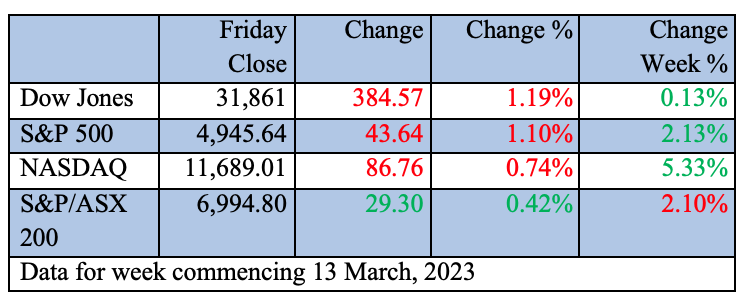
What just happened? It was a weird week in many ways and what happened has left a number of experts with egg on the faces, as central banks showed they still have the power to influence and the money to backstop the system, if there is market, business and consumer negative overreaction. Runs on banks were stemmed, despite some experts arguing that central banks like the Fed were out of ammo because of its rescue efforts since the GFC and then the pandemic smash down of economies and financial markets.
To date, those experts look wrong. We should hope they remain wrong. Even the potential failure of a big bank like Credit Suisse was handled well, with Swiss regulators backing the bank’s overall soundness and its willingness to put money where their mouths were.
It explains why the S&P 500 ended up in positive territory for the week — a week with a bank crisis! But not all this was down to central banks averting a run on banks. No, while this market move higher was more because of the surprise rebound of tech stocks, the central bank still has a role in explaining this sector’s big week.
You see, the banking threat is now seen as another reason to spook businesses and consumers, so it has added new panicked-packed firepower to the Fed and other central banks’ fight with inflation. The bottom line is that in the US and even here with Dr Phil Lowe, the top of the interest rate cycle is more in sight and may already be here.
If the past week’s question marks and bank anxiety persist, central bank rate rises will be doled out with more caution than would’ve been the case if we’d never heard of Silicon Valley Bank, Signature Bank, Silvergate Bank and Credit Suisse in recent news headlines.
And this is good for tech stocks. The Nasdaq was up around 5% for the week, while the S&P 500 was up closer to 2%. The difference was tech. Recently, I’ve talked to you about HNDQ, which buys the top 100 Nasdaq stocks and is hedged. This ETF rose 5.58% for the week, and it’s clearly tech dependent.
I think we’ve seen a sneak preview of the future, when the end of rate rises puts growth stocks back in favour, and it should coincide with a rising $A as the greenback weakens. This chart below shows how the local currency gained friends over the week.
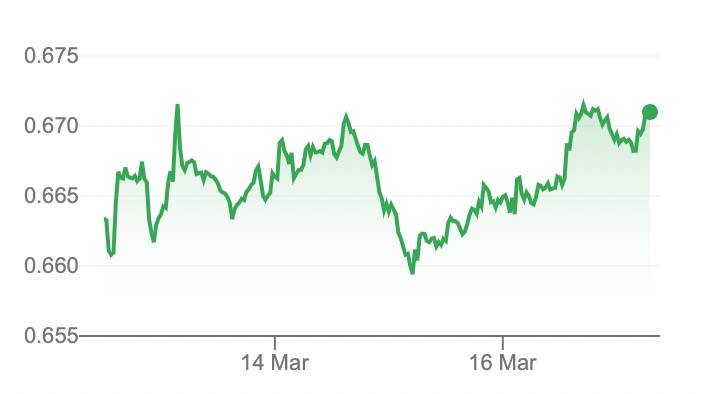
I’m not arguing this ETF has to remain loved in the short term, but it does look an OK long-term play for when tech stocks are back in favour. It’s up 14.26% year-to-date but down 13.54% for the year, though the story in 2023 is getting miles better.
One other important message from this week’s action was that if a bank crisis happens, the US/global recession fear escalates and the $A falls, until rate rises stop and even get replaced by rate cuts. This will eventually help tech/growth stocks. The short-term reaction won’t be good as the media overplays bad news and isn’t used to looking for the long-term pluses that could hose down overall fear. It is what it is but it does create buying opportunities for the confident long-term investor into quality plays.
By the way, those recession fears explain why oil and other energy plays went badly this week. In the US, energy stocks were down around 7% for the week.
But don’t breathe too easy, just yet!
Overnight, bank health anxiety picked up again over the bank that the other banks help to rescue from a run with a US$30 billon gift of deposits. That bank is California’s First Republic, which saw its share price slide 32.8% on Friday, after jumping 10% after the consortium of big US banks, led by J.P. Morgan, seemingly rescued the business. “There’s nervousness into the weekend of: How does this all look on Monday?” explained Keith Buchanan, senior portfolio manager at Globalt Investments. “The market is nervous about holding stocks into that.”
History has taught me that you can’t just assume all is forgotten on stock markets, and especially Wall Street, in a world of short sellers, hedge funds and other serious players who influence the media and therefore can unsettle markets, making a lot of money in the process.
To the local story and despite the high anxiety about the world’s banks, our local money players bounced back on Friday, with market leader CBA rising 1.21% to $96.45. That was a 0.47% move higher for the week. NAB gained 1.65% on Friday but lost 2.48% for the week, while ANZ put on a small 0.4% but was off nearly 4% for the week. Westpac saw a 0.24% rise but gave up 2.34% for the five days’ trade.
For the overall index, the S&P/ASX 200 lost 2.1% for the week but at least bounced by 0.42% on the last day of trading.
Oil also rebounded on Friday — up 2.73% to $31.94 — but was smashed for the week, off 6.61%. Santos did a 1.61% rise on Friday to $6.93 but lost 4% for the five days’ trading.
Here are the big winners and losers for the week, thanks to the AFR and Bloomberg:
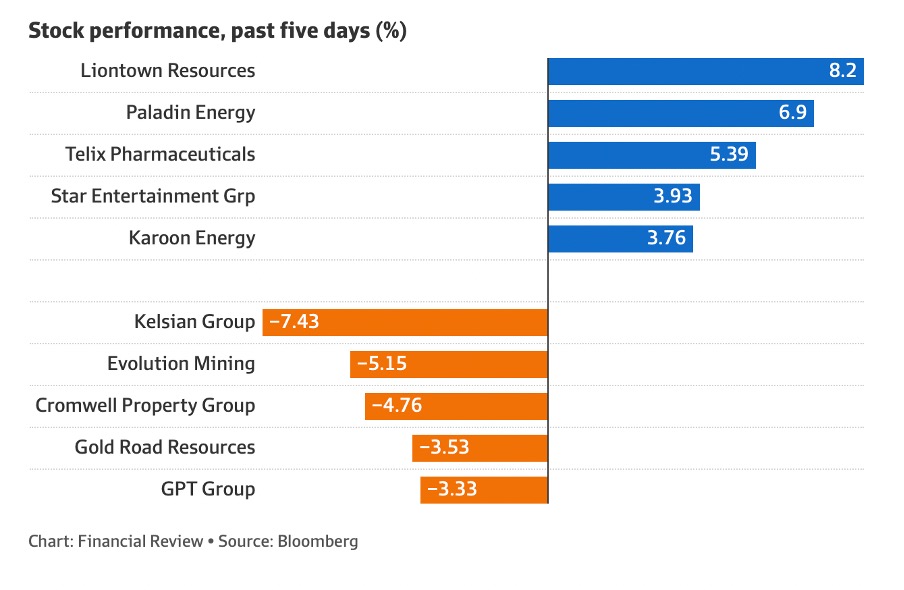
To local tech, and Xero is at long last getting back into the good books — up 4.03% for the week and 16.33% for the month. Alas, Megaport has lost the love of the market. The stock lost 5.94% last week, but Next DC felt a bit of love over the week, rising 1.59%.
Our quality tech is fewer in number compared to the US and they are no way on par with the likes of the FAANG group of stocks. Apple was up 4.75% for the week, while Microsoft spiked 12.12%. That’s quality with a capital Q!
If this banking crisis slows up central bank rate rise activity and we see a comeback of growth stocks, then this hopefully manageable bank problem might make it the bank crisis we had to have. That said, there are a lot of ‘ifs’ and ‘buts’ in this potentially positive analysis!
What I liked
- Leading indicators of jobs growth like the employment component in the monthly NAB business survey and also job ads, have all weakened. This is good for stopping the RBA raising rates.
- The return of net overseas migration continued in early 2023, with a further lift in net permanent and long-term arrivals. The net permanent and long-term arrivals trends are tracking at an annualised figure of 260,000. This is larger than the October Budget estimate of 235,000 for 2022/23.
- This from AMP’s Shane Oliver: “Given the now high risk of recession (which would curtail inflation), it makes sense for central banks to pause rate hikes. This includes the RBA.”
- The New York Empire State Manufacturing Index fell sharply to -24.6 in March, from -5.8 in February. This was a weaker outcome than the -7.9 points the market was expecting. New orders and shipments drove the declines. Additionally, surveyed firms expect some deterioration in business conditions over the next six months. Weak economic data should get the Fed thinking about pausing its rate-rise madness.
- Rate rises in the US might be biting, with retail sales falling by 0.4% over February, which was in line with market expectations, and followed a rise of 3.2% in January.
- US producer wholesale prices declined by 0.1% over February. This was a much weaker outcome than the increase of 0.3% the market was expecting. Producer prices in annual growth terms fell from 5.7% to 4.6%.
- ThePhilly Fed surveywas little changed at a very negative -23.2 against expectations for a bounce to
-15. This is good for reducing inflation.
What I didn’t like
- Unemployment fell from 3.7% to 3.5% and employment growth rebounded in February by 64,000 jobs, which was above the expectation of 50,000. Good news for jobseekers but it could make the RBA raise rates again in April.
- The Westpac/Melbourne Institute reading of consumer sentiment held steady in March at 78.5 but remains in deeply pessimistic territory and is a good reason for the RBA to stop raising rates, at least for a few months.
- The NAB business confidence reading fell 10 points to -4 index points.
- The prices of services less trade, transportation and warehousing advanced 0.3%.
- The ECB raising by 50 basis points — it could be underestimating the fear factor of a banking crisis on normal people.
- There was a sharper-than-expected fall inweekly jobless claims in the US, to 192,000 down from 212,000. Lower jobless claims is not good for killing inflation.
- Ditto for Housing Starts, which were much stronger than expected, up 9.8% against a consensus for little change.
What will be huge next week?
There are two biggies: how the bank challenges play out and then what the Fed does at its interest rate meeting. This is how CNBC sees it, and I think they’re spot on: “The Federal Reserve’s decision on whether to raise interest rates by 25 basis points or implement no rate hike at next week’s policy meeting could depend on what happens in the coming days,” said Nick Timiraos, chief economics correspondent at The Wall Street Journal.
That will be HUGE!
Top Stocks – how they fared…

Best of Switzer This Week
- How do we stop the hackers? https://switzer.com.au/the-experts/peter-switzer/were-under-attack-from-cyber-criminals-what-are-you-going-to-do-about-this/
- Banking crisis deepens: https://switzer.com.au/the-experts/peter-switzer/the-banking-crisis-has-got-scarier-but-how-scared-should-you-be/
- Bank problems good for rates worriers? https://switzer.com.au/the-experts/peter-switzer/bad-banks-dying-might-keep-overborrowed-homeowners-alive/
- Dopey US banks always fail! https://switzer.com.au/the-experts/peter-switzer/another-dopey-us-bank-fails-dont-panic/
- Boom Doom Zoom: https://switzerreport.com.au/video/boom-doom-zoom-16th-march-2023/
- Minns to lead NSW: https://switzer.com.au/the-experts/malcolm-mackerras/minns-will-be-premier-in-a-minority-government/
The Week Ahead:
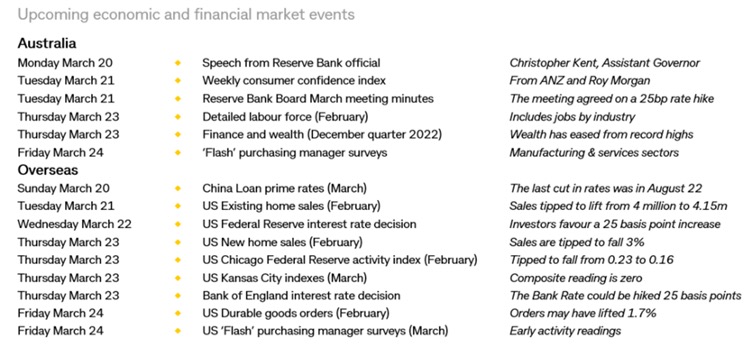
Stocks shorted:
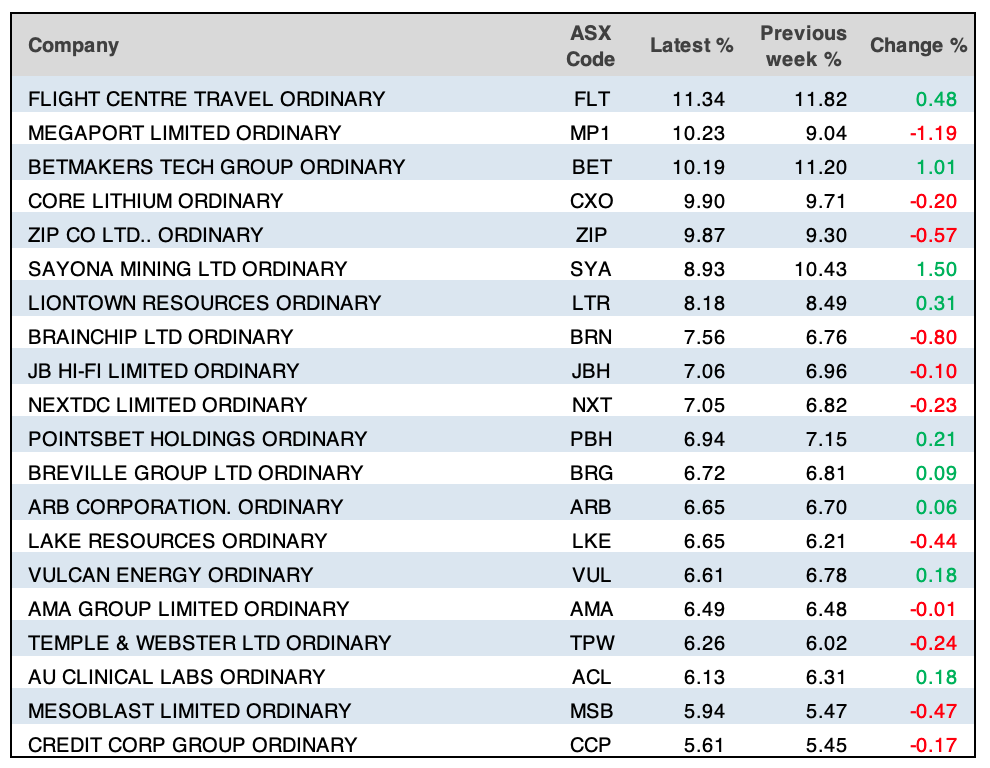
Food for thought
This looks timely from Warren Buffett: “Be Fearful When Others Are Greedy and Greedy When Others Are Fearful.”
But remember what also Warren said about buying quality: “It’s Far Better to Buy a Wonderful Company at a Fair Price Than a Fair Company at a Wonderful Price.”

